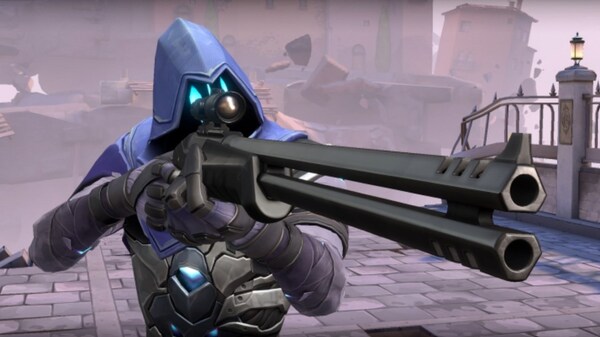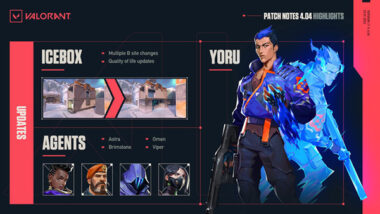Valorant, the popular tactical shooter developed by Riot Games, has taken the gaming world by storm with its unique blend of precise gunplay and strategic abilities. Whether you’re a new player looking to improve or an experienced gamer seeking to refine your skills, this comprehensive guide will help you master Valorant. In this article, we’ll cover essential tips, strategies, and techniques that can elevate your gameplay to the next level.
Introduction
Valorant combines the intensity of traditional first-person shooters with the depth of character-based abilities, creating a challenging yet rewarding experience. Success in Valorant requires more than just sharp aim; it demands strategic thinking, effective communication, and an understanding of each agent’s strengths and weaknesses. This guide will walk you through the key aspects of mastering Valorant, from improving your aim to developing game-winning strategies.

This comprehensive guide will help you master Valorant
1. Understanding the Basics: Agents, Abilities, and Economy
Choosing the Right Agent
Valorant features a diverse cast of agents, each with unique abilities that can turn the tide of a match. To excel in Valorant, you need to understand the role each agent plays and how their abilities can be used effectively.
Agent Roles:
- Duelists: Focused on engaging the enemy and securing kills (e.g., Jett, Phoenix).
- Controllers: Control areas of the map and deny enemy movement (e.g., Brimstone, Viper).
- Initiators: Disrupt the enemy and create opportunities for the team (e.g., Sova, Breach).
- Sentinels: Provide support and defensive capabilities (e.g., Sage, Cypher).
Mastering Abilities
Each agent’s abilities are integral to your strategy. Learn to use them efficiently to support your team, gain information, or eliminate opponents.
Ability Usage Tips:
- Timing is Key: Use abilities at the right moment to maximize their impact.
- Coordinate with Your Team: Abilities are most effective when used in conjunction with your teammates’ actions.
- Practice Makes Perfect: Spend time in custom games or training modes to refine your ability usage.
Managing the Economy
The economy in Valorant plays a crucial role in your success. Properly managing your credits can determine whether you win or lose a match.
Economic Tips:
- Buy Together: Coordinate with your team to ensure everyone has the necessary equipment.
- Save When Needed: If your team is low on credits, consider saving for a full buy in the next round.
- Understand the Buy Phases: Learn when to go for a light buy, full buy, or save, depending on your team’s situation.
2. Improving Your Aim: Techniques and Drills
Finding the Right Sensitivity
One of the most critical aspects of improving your aim is finding the right mouse sensitivity. This can vary based on personal preference, but a lower sensitivity generally offers more control.
Sensitivity Tips:
- Experiment in Training Mode: Try different sensitivities in Valorant’s training range to find what feels comfortable.
- Use a Large Mouse Pad: A larger surface area allows for smoother, more precise movements.
- Consistency is Key: Stick with one sensitivity to build muscle memory.
Crosshair Placement
Proper crosshair placement is essential for landing headshots and winning gunfights. Always aim your crosshair at head level and keep it aligned with common angles where enemies might appear.
Crosshair Tips:
- Pre-aim Corners: Position your crosshair where enemies are likely to appear as you approach corners.
- Head Level: Keep your crosshair at head height to increase the chances of landing a critical hit.
- Adjust to Map Layouts: Different maps may require slight adjustments to your crosshair placement.
Aim Training Drills
Regular practice is necessary to improve your aim. Incorporate aim training drills into your routine to sharpen your accuracy.
Drill Suggestions:
- Flick Shots: Practice quick flicks to targets in the training range.
- Tracking: Work on your tracking abilities by following moving targets.
- Recoil Control: Practice controlling the spray pattern of different weapons to maintain accuracy during sustained fire.
3. Map Knowledge: Understanding Layouts and Callouts
Learning the Maps
Valorant’s maps are designed with strategic play in mind, featuring multiple lanes, choke points, and bomb sites. Familiarizing yourself with each map’s layout is crucial for success.
Key Aspects of Map Knowledge:
- Common Angles: Learn where players commonly position themselves on each map.
- Rotation Paths: Understand the quickest routes between bomb sites and how to rotate effectively.
- Choke Points: Identify areas where enemies are likely to be funneled, making them ideal for ambushes.

Valorant’s maps are designed with strategic play in mind, featuring multiple lanes, choke points, and bomb sites
Effective Callouts
Communication is vital in Valorant. Using accurate callouts helps your team react quickly and efficiently to enemy movements.
Callout Tips:
- Learn the Map-Specific Callouts: Each map has its own set of callouts for specific locations. Learn and use them.
- Keep It Concise: Provide clear and brief information to avoid confusion during intense moments.
- Communicate Enemy Positions: Always relay the location of spotted enemies to your team.
Using the Mini-Map
The mini-map in Valorant provides valuable information, including teammate positions and areas you’ve already cleared. Use it to make informed decisions.
Mini-Map Usage:
- Check Often: Regularly glance at the mini-map to stay aware of your surroundings.
- Coordinate with Teammates: Use the mini-map to track your teammates’ positions and adjust your strategy accordingly.
- Plan Your Movements: Use the mini-map to plan your rotations and flanks.
4. Developing Game Sense: Strategy and Decision-Making
Reading the Enemy
Developing game sense involves predicting enemy behavior and making decisions based on that information.
Tips for Reading Opponents:
- Analyze Patterns: Pay attention to how the enemy team plays each round. Do they rush? Do they play defensively?
- Adapt Your Strategy: Adjust your tactics based on the enemy’s playstyle. If they’re aggressive, consider playing more defensively.
- Use Sound Cues: Listen for footsteps, reloads, and ability usage to gain information on enemy positions.
Making Strategic Decisions
Effective decision-making can turn the tide of a match. Whether it’s when to push, rotate, or hold your position, making the right call is crucial.
Strategic Decision-Making:
- Know When to Push: Push when you have the advantage, such as after securing an early pick.
- Rotate Smartly: Rotate quickly if the bomb is planted on the opposite site, but be wary of potential traps or ambushes.
- Hold When Necessary: Sometimes it’s better to hold your position and wait for the enemy to make a move, especially in a 1vX situation.
Clutching Situations
Clutching is when you’re the last player alive on your team and must win the round on your own. Staying calm and making smart decisions is key.
Clutch Tips:
- Stay Calm: Keep your composure and avoid panicking.
- Play the Time: If the bomb is planted, remember that the clock is on your side. Force the enemy to make the first move.
- Use Sound to Your Advantage: Listen for enemy movements and position yourself accordingly.
5. Teamplay and Communication: Working Together
Coordinating with Your Team
Valorant is a team game, and success often depends on how well you work with your teammates.
Coordination Tips:
- Stick Together: Avoid solo plays unless absolutely necessary. Strength in numbers is a key principle in Valorant.
- Use Abilities in Tandem: Coordinate your abilities with your team for maximum effectiveness. For example, combine smokes and flashes to execute a site push.
- Plan Beforehand: At the start of each round, discuss your team’s strategy, such as which site to attack or how to defend.
Effective Communication
Good communication is essential for coordinating plays and sharing crucial information with your team.
Communication Tips:
- Be Clear and Concise: Provide necessary information without overloading your team with details.
- Call Out Everything Important: Enemy positions, low health, bomb locations—communicate everything that could impact the round.
- Stay Positive: Keep communication constructive, even in stressful situations.
Dealing with Toxicity
Unfortunately, online games can sometimes have toxic players. Knowing how to handle these situations can help maintain team morale.
Handling Toxicity:
- Mute If Necessary: If a player is being disruptive, mute them to focus on the game.
- Stay Positive: Try to keep a positive attitude and encourage your teammates to do the same.
- Report Toxic Behavior: Use Valorant’s reporting system to address toxic behavior after the match.
6. Adapting to Patches and Meta Changes
Staying Updated on Patch Notes
Riot Games regularly updates Valorant with patches that introduce balance changes, new content, and bug fixes. Staying informed about these updates is crucial for maintaining your competitive edge.
Patch Notes Tips:
- Read Official Patch Notes: Review the patch notes released by Riot to understand changes to agents, weapons, and maps.
- Adapt Your Playstyle: Adjust your strategies and agent choices based on the latest changes.
- Experiment in Practice Modes: Test out new changes in custom games or the practice range before jumping into competitive play.
Understanding Meta Shifts
The meta in Valorant refers to the most effective strategies, agents, and weapon choices at any given time. The meta can shift with each patch, so it’s important to adapt accordingly.
Meta Adaptation Tips:
- Follow Pro Play: Watch professional tournaments and streams to see how top players adapt to the meta.
- Be Flexible: Don’t get too attached to a particular agent or playstyle. Be willing to adapt based on what’s currently effective.
- Experiment with New Strategies: Try out different agent compositions and tactics to stay ahead of the meta curve.
Continuing to Learn and Improve
Valorant is a game that rewards continuous learning and improvement. Whether it’s keeping up with patch notes, studying the meta, or refining your own skills, staying dedicated to your growth as a player is the key to long-term success.

Valorant is a game that rewards continuous learning and improvement
Conclusion
Mastering Valorant requires a combination of sharp aim, strategic thinking, and effective teamwork. By understanding the game’s fundamentals, improving your mechanical skills, and staying adaptable to changes, you can consistently perform at a high level. Remember, practice and patience are essential on your journey to becoming a Valorant pro. Keep refining your skills, learning from each match, and, most importantly, enjoying the game.


